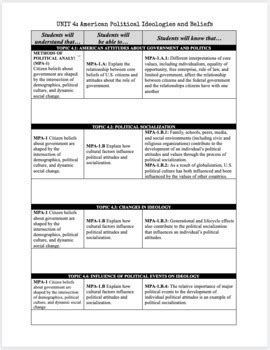In this chapter, we will explore the diverse political ideologies that shape American politics. We’ll examine the core principles of conservatism, liberalism, and libertarianism, and discuss how these ideologies influence public policy and political debates.

Origins of American Political Thought
American political thought has its roots in the Enlightenment, a European intellectual movement that emphasized reason, individualism, and natural rights. These ideas were enshrined in the Declaration of Independence and the Constitution, which reflect the principles of limited government, individual liberty, and the rule of law.
Conservatism
Conservatism is based on the belief in tradition, order, and limited government. Conservatives generally favor free markets, individual responsibility, and a strong national defense. They prioritize stability and the preservation of existing institutions.
Key Principles of Conservatism:
- Individualism and self-reliance
- Limited government intervention
- Free markets and economic freedom
- Strong national defense and law enforcement
- Preservation of traditional values
Liberalism
Liberalism is based on the belief in progress, equality, and government intervention. Liberals generally support social programs, economic regulation, and environmental protection. They prioritize social justice and the expansion of individual rights.
Key Principles of Liberalism:
- Government responsibility to promote social welfare
- Economic equality and redistribution
- Protection of civil liberties and individual rights
- Environmental conservation and sustainability
- Social progress and innovation
Libertarianism
Libertarianism is based on the belief in individual liberty and minimal government interference. Libertarians favor free markets, property rights, and the non-interventionist foreign policy. They prioritize individual autonomy and the reduction of government power.
Key Principles of Libertarianism:
- Individual liberty above all else
- Minimal government intervention in the economy and personal life
- Free markets and open borders
- Voluntary associations and private property rights
- Self-defense and the right to bear arms
Political Spectrum
The political spectrum is a conceptual framework used to categorize political ideologies. It places ideologies on a continuum from left to right, with conservatism on the right, liberalism in the center, and libertarianism on the left.
Political Parties
Political parties are organizations that represent different ideologies and mobilize voters to support their candidates. The two major parties in the United States are the Republican Party, which is generally conservative, and the Democratic Party, which is generally liberal.
Public Opinion
Public opinion is the aggregate of people’s beliefs and attitudes about political issues. Public opinion polls are used to measure the level of public support for different policies and candidates.
Influence of Ideologies on Public Policy
Political ideologies have a significant impact on public policy. Conservative ideologies prioritize tax cuts, deregulation, and reduced government spending. Liberal ideologies prioritize social programs, environmental protection, and expanded healthcare. Libertarian ideologies prioritize individual liberty, free markets, and a non-interventionist foreign policy.
Tables
Table 1: Key Differences between Conservatism, Liberalism, and Libertarianism
| Ideology | Government Role | Economic Policy | Social Policy |
|---|---|---|---|
| Conservatism | Limited | Free markets | Traditional |
| Liberalism | Active | Regulation | Progressive |
| Libertarianism | Minimal | Free markets | Individualist |
Table 2: Political Spectrum
| Left | Center | Right |
|---|---|---|
| Libertarianism | Liberalism | Conservatism |
Table 3: Political Parties and Ideologies
| Party | Ideology |
|---|---|
| Republican | Conservative |
| Democratic | Liberal |
Table 4: Public Opinion on Political Ideologies in the United States
| Ideology | Percentage of Americans Identifying as |
|---|---|
| Conservative | 37% |
| Liberal | 35% |
| Libertarian | 13% |
| Moderate | 15% |
Conclusion
Political ideologies are a fundamental part of American politics. They shape public policy, political debates, and the choices that voters make. Understanding the different ideologies and their influence on politics is essential for informed civic participation.
